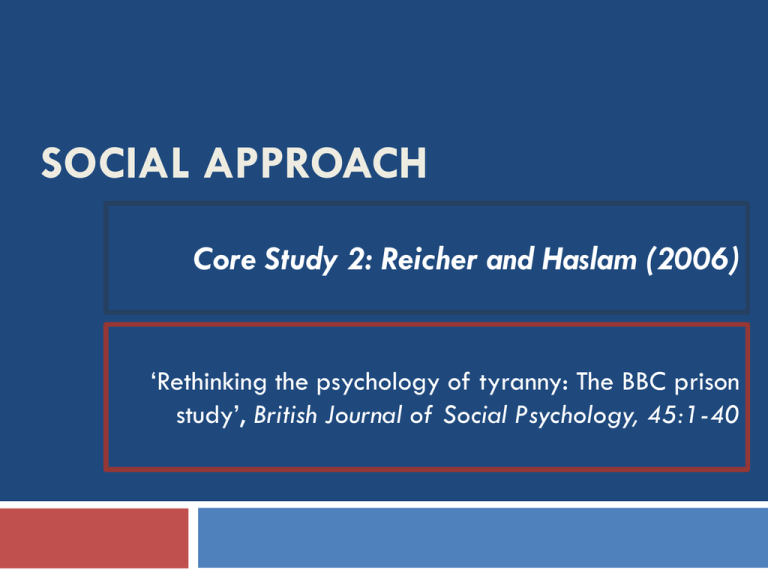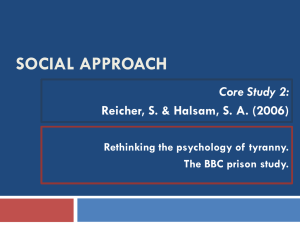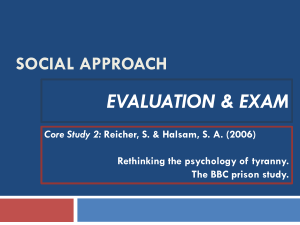Reicher and Haslam Describe Template
advertisement

SOCIAL APPROACH Core Study 2: Reicher and Haslam (2006) ‘Rethinking the psychology of tyranny: The BBC prison study’, British Journal of Social Psychology, 45:1-40 Content Page 1. Approach & Behaviour 2. Aim & Hypothesis 3. Method 4. Design 5. Sample/Participants 6. Procedure 7. Data Collection 8. Results/Findings 9. Conclusions 10. Exam Style Questions SLIDES 1. Approach & Behaviour: Reicher and Haslam Social Approach Insight into group formation, group breakdown and what is the cause of tranny. 2. Aim & Hypothesis: Reicher and Haslam What are the aims (4) of this study? Where do the aims come from? 3. Method: Reicher and Haslam Longitudinal, experimental, case study 3. Method: Reicher and Haslam IV DV 4. Design: Reicher and Haslam 5. Sample & Participants: Reicher and Haslam 1. Describe how the sample was chosen. a. How did Reicher and Haslam recruit their sample? b. How did they choose their sample? 2. Describe who was part of Reicher and Haslam’s sample. (Number, gender, backgrounds of those individuals) 5. Sample & Participants: Reicher and Haslam 1. Describe how the sample was used. 6. Procedure : Reicher and Haslam Describe the setting of the study Describe who was present while the study was taking place. 6. Procedure : Reicher and Haslam(Complete Table) Day Night Before Day One Day Three Day Five Day Six Day Seven Day Eight Event IV 7. Data Collection: Reicher and Haslam • • How did Reicher and Haslam collect their qualitative data? How did Reicher and Haslam collect their quantitative data? 8. Results: Which hypothesis did Reicher and Haslam prove? Situational or Dispositional 8. Results: Reicher and Haslam(Complete Table) Day Night Before Day One Day Three Day Five Day Six Day Seven Day Eight Event IV Outcome 8. Results/Findings: Reicher and Haslam Using the information provided write down 8 results. Your results should include both qualitative and quantitative results. 9. Conclusions: Reicher and Haslam For each conclusion, list one result to support it. 1. People do not automatically conform to their social roles. 2. Groups with power do not always act tyrannically. 9. Conclusions: Reicher and Haslam For each conclusion, list one result to support it. 3. Failing, powerlessness groups can lead to tyranny. 4. It is both practical and ethical to carry out largescale social psychology studies in realistic but controlled conditions. 9. Conclusions: Reicher and Haslam vs Zimbardo How are the two studies the same? How are the two studies different?








